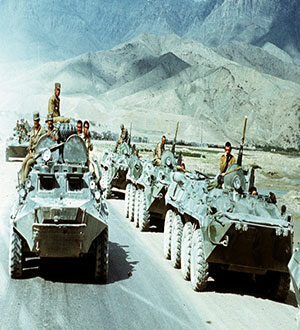The 24th of December 1979
The Soviet occupation of Afghanistan
Elapsed Time: 35 years.
On the 24th of December 1979, The Soviets began their invasion of Afghanistan and within two days, they had secured Kabul, deploying a special Soviet assault unit against Dar Al Aman Palace, where elements of the Afghan army loyal to President Hafizullah Amin put up a fierce, but brief resistance, with Amin’s death at the palace, Babrak Karmal, a Moscow exiled leader of the Parcham faction of the People’s Democratic Party of Afghanistan (PDPA) was installed by the Soviets as Afghanistan’ s new head of government.
It was impossible for both World decision makers and political Analysts to believe that they had been totally unaware of the struggle of the Mujahideen against the Taraki and Amin regimes, and how close to success they were when Brezhnev moved his troops to save his puppets a number of theories have been advanced for the Soviet action, these interpretations of Soviet motives do not always agree , what is known for certain is that the decision was influenced by many factors ,that in Brezhnev’s words the decision to invade Afghanistan was truly “no simple decision”.
Two factors were certain to have figured heavily in Soviet calculations, the Soviet Union, always interested in establishing a cordon sanitaire of subservient or neutral states on its frontiers, was increasingly alarmed at the unstable, unpredictable situation on its southern border, and most important was the major event in that area which took place only nine months ago, the huge triumph of the Islamic Revolution in neighbouring Iran and the genuine fear of the eventual “contamination” .
To make further parallels, as Nicholas II, who made the great mistake of attacking the seemingly “weaker” opponent Japan in 1904, thus suffering a disastrous defeat Nicholas faced waves of strikes which paralyzed the economy; the same scenario was to be repeated by Brezhnev when he invaded the “easy” Afghanistan , totally ignoring local history and high Islamic traditional patterns.
Whatever the Soviet goals may have been, the international response was sharp and swift, the US President Jimmy Carter, reassessing the strategic situation in his State of the Union address in January, 1980, identified Pakistan as a “front-line state” in the global Struggle against communism as it is now a “front line state” against the so called “war on terror”.
He reversed his stand of a year earlier that aid to Pakistan be terminated as a result of its nuclear program and offered Pakistan a military and economic assistance package if it would act as a conduit for United States and other assistance to the Mujahideen, Pakistani president Zia ul-Haq refused Carter’s package but later a larger aid offer from the Reagan administration was accepted, questions about Pakistan’s nuclear program were, for the time being, set aside ,assistance also came from China, Egypt, and Saudi Arabia; also forth coming was international aid to help Pakistan deal with more than 3 million fleeing Afghan refugees.
The Soviet invasion had a devastating effect on the Afghan people, because the rural population fed and housed the Mujahideen, the Soviets tried to eliminate or remove civilian populations from the countryside where resistance was based, in this connection, Soviet bombing destroyed entire villages, crops and irrigation, leaving millions of people dead, homeless or starving, land mines maimed unsuspecting Afghans, especially children who mistook them for toys.
 Mouood Mouood English Edition
Mouood Mouood English Edition




